#startlight submissions
Text
4cr Plays - Persona Dancing: Endless Night Collection (PS4)
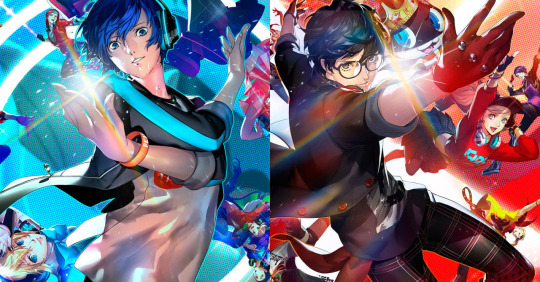
It’s a testament to the strength of the casts in the Persona series that its characters can appear in spinoffs in so many disparate genres and feel like naturals. Fighting game? Sure, they can duel each other to submission. First-person dungeon crawler? That’s basically what they did already, from a new perspective. Dance off? Why not?!
The last one is our focus today. A couple of years back, the Persona 4 cast took to the stage in Persona 4: Dancing All Night. Despite the absurdity of the core premise - the investigation team must dance to protect missing idol singers from monstrous shadows - the game was a delight. It was pure fanservice, but damn, I adore those characters and that soundtrack. I’ll dance the night away with Chie and Rise any day of the week.
Now, Atlus has returned to the rhythm genre with a pair of games applying the same formula to the soundtrack and casts of Persona 3 and Persona 5. Persona 3: Fancing in Moonlight and Persona 5: Dancing in Startlight launch this week on PS4 and PS Vita - either separately for $60 each or in a dual pack - with a PS4 version of Persona 4: Dancing All Night - for $99.
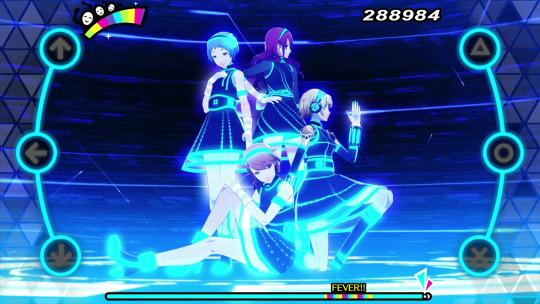
I should start off my impressions with a disclaimer. I am not a big fan of rhythm games. I love music, but I am basically tone-deaf and have the reaction times of a pineapple. I suck at games that require matching any sort of beat. I am, however, a massive fan of the Persona series. So, this review is going to be from that perspective more than a look at the games as a fan of the rhythm genre.
That said, the gameplay of the Persona dancing games is thoroughly in the vein of something like Dance Dance Revolution or Guitar Hero - pressing the right buttons in time with the notes. Basically, as you work through a song, notes will stream from the center of the screen to the edges. You must press one of six buttons as the note nears the edge of the screen - the down, left, and up buttons on the d-pad and the triangle, circle, and X buttons on the right. When the note lines up with a circle on the edge of the screen, press the corresponding button.
There are also a number of special notes that require some more effort. Some note must be held - press the button in time and keep it down until indicated. Others require two buttons to be pressed simultaneously. The last element are the “scratches”. When these circles near the edge of the screen, you need to flick one of the analog sticks (scratches can also be mapped to the triggers). The scratches are important, as hitting the right ones will activate a special “fever mode” - where a score multiplier is activated, and where you can save yourself if you’ve been falling behind.
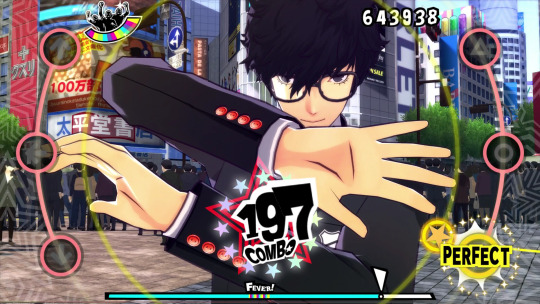
Scoring is based on how well you landed notes, ranging from perfect, to very good, to good, and to a miss. Too many misses, and you’ll fail the song. At the end, the number of hits in each category and your combo will determine your final score. An early miss will harm you less than a miss at a critical moment that breaks a long-running combo. Keep in mind - “good” ratings are a hit, but will also break a combo. You need to make a lot of “perfect”s and “very good”s to top the boards.
This is the same basic formula at the heart of Persona 4: Dancing All Night (P4D). As a rhythm outsider, I don’t think there have been any fundamental changes - if you liked it there, you’ll be fine. If you hated it, I doubt this will change your mind. For my part, I think it works well. The controls feel responsive enough. There are multiple difficulty levels - higher ones up the speed and number of notes. I tended to stick to “normal”, and did just fine. I didn’t go near the higher difficulty levels, but know some fiends will work to master the highest tiers. I wish them, and their superhuman reflexes, the best of luck.

Of course, the attraction here is definitely the music. The Persona series features some of the best soundtracks in gaming. The great part too is that those soundtracks are quite different. The music in Persona 3 is vastly different from that in 4 and 5, so the experience feels fresh across games. That said, splitting the soundtracks over games makes each feel a bit thin. Some of the same basic songs appear multiple times, with remixes and live versions. As a result, the tracklists seem a bit thin. Few songs are true duds, but I didn’t care for some of the remixes.
Still, the soundtracks are great, and the presentation is top-notch. Both games look great - clean, colorful, and sharp. I realize that creating the sets for a rhythm game is a smaller task than creating a full explorable world, but seeing all of the Persona 3 settings recreated in HD really made me wish that Atlus would remake P3 and P4. This is the sharpest, cleanest presentation of these settings and characters that have existed. It can be a little hard to tell what is happening on screen at times, with all of the effects in full blast. However, this is definitely a fun game to watch. It’s a visual treat.
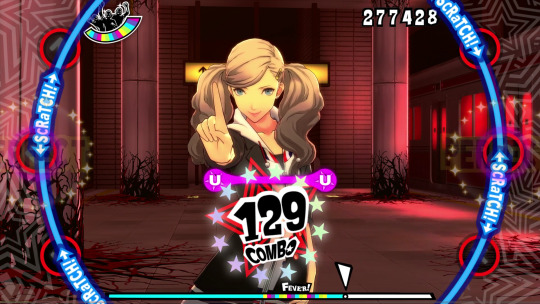
A number of factors can be customized during dancing. There are track modifiers that can be enabled to make the experience either easier or harder. For example, one modifier prevents “good” hits from breaking a combo. However, the modifiers that make playing easier will cost you points. Other modifiers make the experience more devilish. You can also outfit dancers in a huge variety of outfits and accessories - from wigs, to glasses, to headphones. The more you play, the more clothing options you can unlock. After the first playthrough, you can also select different dance partners. Both costumes and the backup dancers are pure fanservice, but some Persona fans will have fun playing with different options.
P4D had an extensive story mode to supplement the core dancing. A lot of people found the story mode boring, but I really liked it. I love the Persona 4 characters, and thought the story was an interesting look at the issues with idol culture in Japan.
Sadly, the two new games have both dropped the story mode entirely. Instead, a basic “it’s a dream” framing device is used to justify the dancing, and that’s about it. Instead, checking off requirements in the dancing mode will open up “social link” scenes with the individual cast members. These are fun little fully-acted vignettes, and progress a bare-bones overall plot. Later scenes let you explore each character’s bedroom. If you have a PSVR, you can activate it and walk through each area in first-person. As a fan, these scenes are cool. I love spending a little more time with both casts. However, you definitely notice the loss of a dedicated story mode. The scenes feel inconsequential without any central driving plot - just a bonus for fans of the series.
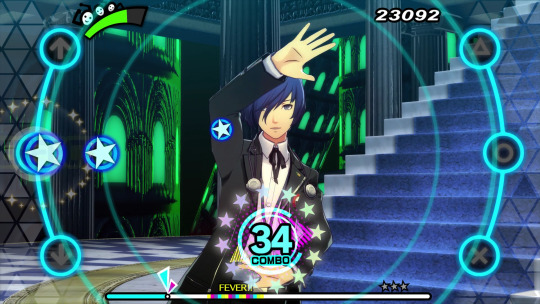
Ultimately, your enjoyment of these games will depend on how much of a Persona fan you are. The soundtracks are incredible, the dancing is fun enough, and the presentation looks great. However, the experience is thin on content, especially at full price. I’m not sure I could recommend either game at $60 each. These feel like budget releases tossed out at full price, and should have just been one game from the start. The $99 collection has more merit - especially since it includes a PS4 version of P4D. Looking at is as $33 per game, it doesn’t seem bad at all. If you’re a fan of the series as a whole - if you love those casts and the soundtracks - the full collection may be worth your time. If you aren’t already a Persona super-fan, I don’t think there’s as much to recommend at the high cost of entry.
This review is based on a copy provided by the publisher, Atlus.
Official Website
1 note
·
View note